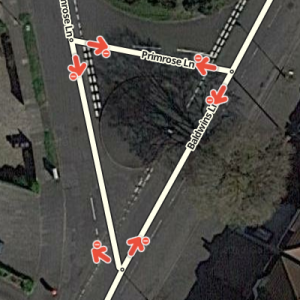Introduction
| This forms part of UK Editing Best Practice. Editor are encourage to follow these guidelines. |
As with all mapping in Waze, all types of junctions should be drawn as simply as possible to give clear instructions. At this time, November 2017, Waze does not give lane guidance and adding additional segments at junctions can lead to complex & confusing instructions and the possibility of introducing errors. For a comprehensive guide on editing junctions in general please read the Global Junction Style Guide.
Junctions
T-junctions, cross roads, and the majority of junctions are usually best mapped as single 2-way segments that are connected with a single node. Complex junctions that include restrictions, large (distinct) turn lanes may benefit from a more complicated layout.
The original UK map import , know as the UK basemap, had a lot of junctions mapped as split 1-way roads due to little more than some painted chevrons in the middle of the road. This is completely unnecessary, and any remaining should be simplified where possible.
 |
 |
Roundabouts
Roundabouts are no exception, most can be mapped with single 2-way segments for each connecting road. Much of the UK basemap had pairs of 1-way entry and exit segments which are not necessary. If you are rebuilding a roundabout take the opportunity to remove these segments. They will look much better on the client and can lead to normal roundabout instructions.
Steps for redrawing a roundabout
 |
 3. Drag 2-way segments to the centre |
 |
Small and mini-roundabouts should be drawn as large as possible. Roundabouts drawn with a radius less than 10m will not be easily visible on the App, so aim to get them close to this size if you can, this may mean drawing it larger than the road itself.
| You can read more in depth on Roundabout in the Global Wiki pages. |
New roundabouts
After drawing a new roundabout, it is important to change the road type to the most appropriate Road Type (except Freeway), and set the address. To aid navigation instructions, roundabouts should not be given a Street name. If the roundabout does have a proper, signposted name, then for this can be mapped using an Area Place, with the category Junction/Intersection, that fills the centre of the roundabout.
Common issues with roundabouts
- If a roundabout does not have — — — dashed line through the center of its segments, then it is not a proper roundabout but a group of 1-way segments. The client will give keep left and keep right instructions instead of take the nth exit. These junctions should to be deleted and redrawn. Note: If a single segment of a roundabout is selected the info panel will include a button to Select entire which will select all segments of that roundabout.
- If two entry and exit segments share the same junction node on the roundabout, the exit will not be counted when entering at that junction, instructions will then give the wrong exit count. Entry and exit segments should always be connected via separate junctions.
- Sometimes the client will say "Take the 0th exit" for a roundabout. This is often caused by an invisible node on or within the junction, and can only be repaired by deleting and rebuilding the entire roundabout.
- Roundabouts with a diameter of 10m or less won't be used for u-turns in a waze route (this is a country specific configuration).
Special Roundabouts

Sometimes a roundabout will get modified to change its shape and function, such that it is no longer a simple a roundabout.
One such example is the Hamburger Roundabout, where the main carriageway goes straight through the middle of the junction. This should be drawn as if the main road was an over pass, with short ramps connecting it to the roundabout. The example here is near M62 Junction 27 (Leeds).
Some roundabouts get modified so much that they can no longer be considered roundabouts at all. This can be seen at M62 Junction 31 (Castleford)
Triangular Junctions

We have quite a lot of triangle junctions in the UK. Some of them are so small they have nothing more than a few square metres of grass in the middle and can usually be simplified into T-junctions.
If they're left as triangles, they can be problematic. For any route through the junction, there are 2 possibilities: the "sensible" route following one side of the triangle; and the "silly" route following 2 sides. Because the triangles generally aren't very big, GPS accuracy isn't good enough to distinguish which route a driver actually takes. So if Waze decides a silly route is faster, then for most drivers who ignore it and take the sensible route, Waze will still think they've gone the long way round and reinforce that route.
If a triangle is large enough to be mapped (e.g. has a large amount of grass or a tree on it), then restrict all internal turns to force Waze to use the sensible route through these junctions.